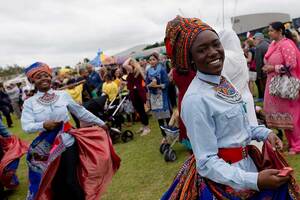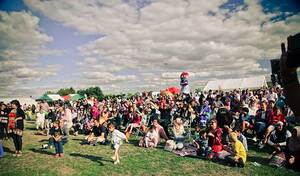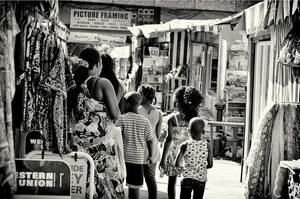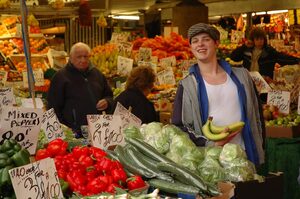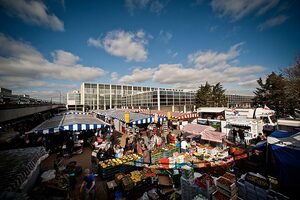Milton Keynes is a New Town built in the 1970s to relieve housing pressure in London. Originally home to a largely homogenous population of skilled workers from the capital city, it has recently undergone a prominent ethnic shift: the BME population has doubled between 2001 and 2011, reaching 26%. The city is also growing rapidly, and is soon expected to reach 500,000 inhabitants. However, like many new towns, Milton Keynes is facing an identity problem. Despite strong grassroots cultural organizations, it suffers from a perceived lack of culture. How can the city’s thriving cultural scene be reflected in its image? And how can its growing cultural diversity be expressed in its identity?
City Origins
Milton Keynes is famous for being one of the last and arguably greatest New Towns built in the UK under the post-war 1946 New Towns Act. It was unique because of its scale (89km2) and ambition. From the beginning, it built to be a city in its own right. Located equidistant from London, Birmingham, Oxford and Cambridge, its position gives it a natural geographic and economic advantage. Resultingly, Milton Keynes attracted people and businesses from the very start and has had the best performing economy in the UK over the last decade.
The 1970 Masterplan: a ‘City in a Forest’
Milton Keynes’s original 1970 Masterplan envisaged a city of 250,000 people, an urban utopia of equality and a city of leisure and culture. The early days of the Development Corporation saw huge investment in infrastructure and the development of a unique ‘Framework’ of grid roads, separate pedestrian and cycling ‘Redways’, and corridors of linear parks and waterways in which the housing, employment and other buildings and land uses were dispersed. The city’s low density and respect for existing historic towns and villages, plus its generous green space (some 26% of all land use) has given it a feel of a rural city, often called a ‘City of Trees’ or a ‘City in a Forest’.
Rapid Growth
Throughout the 1970s, 80s and 90s, Milton Keynes continued to follow the Masterplan with very few changes, but with commercial developers replacing the Development Corporation as major housebuilder. Then, in 2005, a new Growth Agenda for the city was announced and a change in housing density on the flanks of the city was promoted to meet the new target of a city of 350,000. Ten years later, a new Local Plan (Plan:MK) is currently in consultation to anticipate even more growth, maybe even to 500,000 people. Many of the residents are rightly concerned about what that means for the city’s uniquely designed framework, which they have come to call their home. In response, a MK2050 Futures Commission was set up, and its 2016 report made several recommendations to the city about future development.
The New Town Lab: How can Existing Culture Become More Perceptible?
Milton Keynes has decided for its New Town Lab to focus on Culture. Culture has always been a strange beast in new towns. To many people who live outside new towns, the perception is that new towns lack any culture. In fact, quite the opposite is true. It was built on an existing historic landscape, and many significant sites and collections are hidden throughout the city. Moreover, it has many cultural organisations, most of which started as volunteer groups. The infrastructure for these organisations has, over the past 50 years, been built in accordance with the Masterplan and wishes of the people.
Improving the Cultural Programme
The Growth Agenda and MK2050 Futures Commission has highlighted that, if the Milton Keynes is to transform itself into a respected European and International city, it needs a step-change in culture. Milton Keynes does not have a coherent annual citywide programme, and it lacks depth and breadth. Moreover, young and emerging talent have no (affordable) venues in what is a highly commercialised city centre. As well, the cultural make-up does not reflect the rapid demographic diversity that Milton Keynes is experiencing (up from 9% BAME in 2011 to 26% in 2016).
International Ambition
In 2015, Milton Keynes Council agreed across all political parties to support a bid for the UK nomination to be its 2023 European Capital of Culture and since then, all areas – education, health and wellbeing, social, economic, housing, transport and mobility – have started to see that culture is the ‘glue that brings people together’: it provides a sense of identity, place and pride. The city has a long way to go, especially if it is to return to one of its original principles of a city ‘fairer for all’, but there is a new impetus around culture, for which we invite you to share your thoughts and ideas.
Facts
Established: 1967
Population: 265,000
BME: 26%
Strengths
– Location equidistant from major cities has created a strong and diverse economy
– Robust infrastructure: road grid, pedestrian and cycling ‘redways’
– linear parks and waterways
– strong grassroots cultural organizations
– multicultural with 100+ nationalities and numerous cultural festivals
– modernist architecture with national heritage recognition
Challenges
– accommodate population growth to 500,000 people
– perception that new towns lack culture
– insufficient citywide culture programme and venues for emerging talent
– demographic diversity not reflected in cultural make-up
Questions for New Town Lab
– How have new incoming migrants and communities contributed to shaping Milton Keynes’s culture?
– How can Milton Keynes’s cultural diversity be positively reflected in the city’s policies, urbanism, and identity?
– How can migration, identity and culture help Milton Keynes to develop into The Creative and Cultural City?




